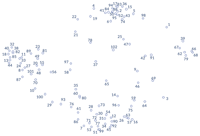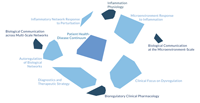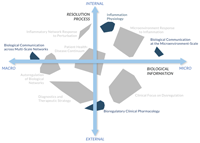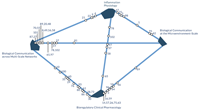Group Concept Mapping
Based on a group concept mapping process, individual inputs were analyzed in order to establish relationships among the items drafted from literature review and expert meetings.
- A two-dimensional point map was generated to visualize emergent group consensus.
- Based on structural and functional analysis, a cluster map was developed to visualize higher order themes.
- Conceptual patterns revealed how the content is distributed across the two-dimensional model representation. Experts examined the model, identifyingfour anchor clusters.
For a detailed explanation of concept mapping analysis, please refer to the White Paper.

Each point in the figure represents one of the 102 statements derived through extensive literature mining and expert consensus, and considered to represent a key component of the Bioregulatory Systems Medicine conceptual model. Items number from 1 to 102, and each item number was assigned randomly for ease of reference. Statements that appear closer to one another on the point map tend to be thought of as more conceptually similar by those who participated; statements that appear farther apart tend to be thought of as more conceptually distinct.

The labels assigned to each cluster reflect the shared higher-order themes that describe the more specific statements within each cluster and in a way that conveys its meaning in the context of the Bioregulatory Systems Medicine paradigm. Cluster labels were derived and finalized by the authors and contributing reviewers that championed the model development initiative.

The figure illustrates the conceptual dimensions and anchors of the model that emerge from the group concept mapping process, analysis, and interpretation of the interrelationships among the clusters. The dimension that appears vertically in this figure is labeled "Resolution Processes," as the content along this axis relates to participants' conceptualization of disease resolution occurring through both internal and external mechanisms. The horizontal dimension is labeled “Biological Information," along which the content relates to communication within and across micro and macro levels of biological organization. Intermediate and central clusters are displayed in gray to contrast their location along the dimensions and with respect to the anchor clusters (dark blue).

The intermediary clusters are those that are spatially located between the anchor clusters, and can be described as conceptual bridges that strongly relate to their respective neighboring anchors. The figure illustrates the statements of each intermediary cluster as arranged between each cluster’s corresponding anchors. A statement’s distance from either anchor reflects the relative strength of relatedness that participants collectively perceived among that particular statement and the neighboring anchors. The degree to which the space (blue line) between each anchor is relatively evenly populated with statements may suggest the extent to which the intermediary cluster effectively functions as a conceptual bridge between the anchors.
